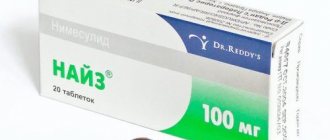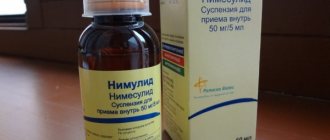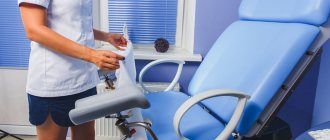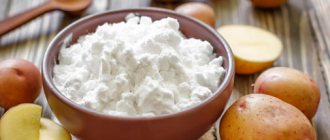Indications and contraindications for Nise therapy
The instructions for the drug indicate that the medication helps with acute attacks of pain and primary dysmenorrhea. Nise is prescribed as a medicine for secondary therapy; the risk of adverse reactions is preliminarily assessed for each patient. The list of diseases for which the medication is effective is presented:
- rheumatoid, psoriatic arthritis;
- articular syndrome that occurs during an exacerbation of gout;
- ankylosing spondylitis;
- osteochondrosis, osteoarthrosis;
- muscle pain;
- pain syndrome that occurs after injuries, surgical interventions, etc.
The drug is contraindicated:
- in case of individual intolerance to nimesulide or other ingredients of their component composition;
- the appearance of nettle fever, allergy symptoms due to previous use of Aspirin or other NSAIDs;
- treatment with other drugs with toxic effects on the liver;
- alcohol or drug addiction;
- bleeding from the gastrointestinal tract, damage to the gastric mucosa when taking NSAIDs;
- problems with the rate of blood clotting;
- dysfunction of the kidneys, heart, liver;
- clinical signs of influenza, ARVI.
The medicine is not used during lactation and in the last trimester of gestation. The drug is contraindicated in patients under twelve years of age and is not used when planning pregnancy due to its effect on fertility.
Nise
NSAIDs. A selective inhibitor of COX-2, an enzyme involved in the synthesis of prostaglandins - mediators of edema, inflammation and pain. The drug has anti-inflammatory, analgesic and antipyretic effects.
Reversibly inhibits the formation of prostaglandin E2, both at the site of inflammation and in the ascending pathways of the nociceptive system, including the pathways of pain impulses in the spinal cord.
Reduces the concentration of short-lived prostaglandin H2, from which prostaglandin E2 is formed under the action of prostaglandin isomerase. A decrease in the concentration of prostaglandin E2 leads to a decrease in the degree of activation of EP-type prostanoid receptors, which is expressed in analgesic and anti-inflammatory effects.
It has a slight effect on COX-1 and practically does not interfere with the formation of prostaglandin E2 from arachidonic acid under physiological conditions, thereby reducing the number of side effects of the drug.
The drug suppresses platelet aggregation by inhibiting the synthesis of endoperoxides and thromboxane A2, and inhibits the synthesis of platelet aggregation factor. Suppresses the release of histamine and also reduces the degree of bronchospasm caused by exposure to histamine and acetaldehyde.
The drug also inhibits the release of tumor necrosis factor alpha, which causes the formation of cytokines.
It has been shown that nimesulide is able to suppress the synthesis of interleukin-6 and urokinase, thereby preventing the destruction of cartilage tissue. Inhibits the synthesis of metalloproteases (elastase, collagenase), preventing the destruction of proteoglycans and collagen of cartilage tissue.
It has antioxidant properties and inhibits the formation of toxic oxygen breakdown products by reducing the activity of myeloperoxidase. Interacts with glucocorticoid receptors, activating them through phosphorylation, which also enhances the anti-inflammatory effect of the drug.
When applied topically, it causes a weakening or disappearance of pain at the site of application of the gel, incl. pain in the joints at rest and during movement, reduces morning stiffness and swelling of the joints. Helps increase range of motion.
Pharmacokinetics
Suction
After oral administration, nimesulide is well absorbed from the gastrointestinal tract. Eating reduces the rate of absorption without affecting its extent. Cmax of nimesulide in blood plasma is achieved 1.5-2.5 hours after administration and is 3.5-6.5 mg/l. Subject to a first-pass effect through the liver.
Distribution
Binding to plasma proteins is 95%, to erythrocytes - 2%, to lipoproteins - 1%, to acidic α1-glycoproteins - 1%. The dose of the drug does not affect the degree of binding to blood proteins.
Vd is 0.19-0.35 l/kg. Penetrates into the tissues of the female genital organs, where after a single dose the concentration of nimesulide is about 40% of the concentration in plasma. Penetrates well into the acidic environment of the inflammation site (40%) and synovial fluid (43%). Easily penetrates histo-hematological barriers.
Metabolism
Nimesulide is actively metabolized in the liver by tissue monooxygenases. The main metabolite, 4-hydroxynimesulide (25%), has similar pharmacological activity.
Removal
T1/2 - 1.56-4.95 hours, T1/2 of 4-hydroxynimesulide - 2.89-4.78 hours. The metabolite is excreted by the kidneys (65%) and bile (35%).
Pharmacokinetics in special clinical situations
In patients with renal failure (creatinine clearance from 80 to 30 ml/min), as well as in children and the elderly, the pharmacokinetic profile of nimesulide does not change significantly.
Dosages and application options according to the instructions for Nise
A reduction in unwanted reactions of the body during therapy is ensured by the maximum permissible doses and a short course of treatment. Therapeutic procedures do not exceed 15 consecutive days.
The treatment regimen depends on the age of the patient and the current pathological process:
- adults – 0.1 g twice a day after meals;
- elderly - similar to adults, without changes in dosage;
- children 12-18 years old - 100 mg twice a day.
The abstract draws attention to some features:
- mandatory reduction of Nise dosage for patients with impaired renal function;
- possible deterioration of visual acuity when taking NVPS, fluid retention in tissues;
- prohibition on joint use with analogues from the same pharmacological group.
During treatment, regular monitoring of the gastrointestinal tract is required. Due to the high risk of developing drowsiness and inhibition of reactions, during Nise therapy you should avoid driving vehicles, working with complex moving mechanisms, and activities that require precise coordination of movements and speed of reaction.
Nise - tablet composition
The active ingredient of the described medication is nimesulide in an amount of 100 mg per pill. This substance is a non-steroidal chemical compound from the sulfonanilide group. It inhibits the production of enzymes that are involved in the synthesis of mediators of pain, swelling and inflammation. There are also auxiliary components added to Nise - the composition includes:
- calcium hydrogen phosphate;
- corn starch;
- microcrystalline cellulose type 114;
- sodium carboxymethyl starch;
- magnesium stearate;
- colloidal silicon dioxide;
- purified talc.
Adverse reactions and overdose
Clinical studies have shown that use of the drug in high dosages may increase the risk of developing diseases caused by arterial thrombosis. During therapeutic manipulations, patients experienced swelling, increased blood pressure, and heart failure.
Common adverse reactions to Nise include:
- bleeding from the gastrointestinal tract;
- peptic ulcers, gastric perforation;
- attacks of vomiting with nausea;
- active gas formation, diarrhea;
- dyspeptic disorders;
- pain in the abdominal area;
- tarry stools, ulcerative stomatitis.
The development of gastritis was observed less frequently in patients.
Accidentally exceeding the prescribed amount of Nise can cause drowsiness, apathy, discomfort in the epigastric region, vomiting with nausea. These phenomena are reversible and can be treated with symptomatic treatment.
Sometimes there is an increase in blood pressure, respiratory depression, bleeding from the gastrointestinal tract, and coma. An overdose of NSAIDs threatens the development of allergic reactions, including angioedema and anaphylaxis.
The pathological condition is treated with maintenance therapy using activated carbon (1 tablet per 10 kg of body weight) or an osmotic laxative. At the same time, renal and hepatic functionality is monitored.
Nise tablets - what are the instructions silent about?
Anti-inflammatory analgesics sometimes have to be taken in long courses, so doctors advise choosing the safest and most effective drugs. The group of such drugs includes Nise, an effective pain reliever that rarely causes negative side effects. Before using it, it is important to carefully study the instructions.
How many hours does nise last?
Nise is a non-narcotic drug belonging to the group of non-steroidal anti-inflammatory drugs (NSAIDs).
- analgesic effect;
- antipyretic effect;
- anti-inflammatory effect.
Nise reduces body temperature, inflammation, pain of varying intensity, redness and swelling of soft tissues. Moreover, the drug has the above effects regardless of the location and cause of pain/inflammation. The drug also has an antioxidant effect and slows down the formation of toxins.
Overdose
Symptoms of an accidental overdose of Nise:
- Increased blood pressure;
- Development of liver failure;
- Irritation of the gastrointestinal tract;
- Renal dysfunction;
- Respiratory depression;
- Convulsions;
- Coma.
Treatment of Nise overdose:
- The patient undergoes gastric lavage (through a tube);
- Activated carbon is prescribed;
- Osmotic laxatives are indicated;
- Detoxification (including forced diuresis) and symptomatic therapy are carried out;
- In severe cases, extracorporeal detoxification methods are indicated: hemosorption and hemodialysis.
Composition of the drug Nise
The drug is available in the form of tablets, suspension and gel for topical use.
The main active ingredient in all dosage forms of Nise is nimesulide. Tablets for oral administration contain 100 mg of nimesulide; Dispersible tablets – 50 mg; Suspension – 50 mg of nimesulide per 5 ml of solution; Gel – 1% (10 mg nimesulide per 1 g).
Figure 1 - Nise in tablets at temperature
Indications for use
Nise is able to relieve pain, reduce fever and reduce inflammation, but the drug does not cure the disease that caused such reactions. This means that Nise is a symptomatic remedy, and to treat the disease it is necessary to use a medicine designed specifically for this purpose.
Nise is indicated in the following cases:
- rheumatoid arthritis;
- gouty and psoriatic arthritis;
- osteoarthritis;
- osteochondrosis with pain syndrome;
- tendinitis, myositis;
- pain of various origins and localization;
- fevers of various origins;
- pain syndrome due to injuries in the postoperative period, thrombophlebitis, gynecological diseases.
- lumbago;
- rheumatoid arthritis;
- tenosynovitis;
- bursitis;
- sciatica;
- damage and inflammation of ligaments and tendons;
- myositis;
- psoriatic arthritis;
- ankylosing spondylitis;
- osteochondrosis with the presence of radicular syndrome;
- bruises and injuries;
Figure 2 - Tablets are good for bruises and injuries
- myalgia (muscle pain);
- arthralgia (joint pain);
- increased body temperature of any origin;
- inflammatory process of the ENT organs and respiratory tract during viral or bacterial infections.
Contraindications
The drug Nise is contraindicated:
- hypersensitivity to the components of the drug;
- dermatosis;
- skin damage (for Nise gel);
- infectious and inflammatory process in the area of application of the gel;
- pregnancy and breastfeeding;
- bronchial asthma, combined with nasal polyps and intolerance to Aspirin or other NSAIDs;
- stage of exacerbation of erosive and ulcerative lesions of the digestive tract;
- gastrointestinal or bleeding of any other location;
- exacerbation of inflammatory bowel diseases;
Figure 3 - It is contraindicated to take Nise with alcohol
- hemophilia;
- bleeding disorders;
- heart failure in the stage of decompensation;
- liver failure or liver disease in the acute stage;
- liver damage in the past that occurred while taking drugs containing nimesulide;
- alcoholism;
- addiction;
- renal failure with creatinine clearance less than 30 ml/min;
- hyperkalemia;
- the first 2 – 3 months after coronary artery bypass grafting;
- age under 12 years for tablets, 3 years for dispersible tablets and 2 years for suspension.
Side effects
When using Nise, the following side effects may develop:
- Digestive system: nausea, diarrhea, vomiting; flatulence, constipation, gastritis; stomatitis, abdominal pain, gastrointestinal bleeding, tarry stools, ulcers and/or perforation of the stomach or duodenum;
- Cardiovascular system: arterial hypertension; hemorrhages, tachycardia, hot flashes;
- Skin: itching, increased sweating, rash; dermatitis, erythema; swelling of the face, exudative erythema multiforme, including Stevens-Johnson and Lyell syndrome;
- Liver and biliary system: increased liver transaminases; fulminant hepatitis, hepatitis, jaundice, cholestasis;
- Urinary system: edema; dysuria, urinary retention, hematuria, hyperkalemia; oliguria, renal failure, interstitial nephritis;
- Central nervous system: dizziness; feeling of fear, nightmares, nervousness; drowsiness, headache, encephalopathy (Reye's syndrome);
- Respiratory system: shortness of breath; bronchospasm, exacerbation of bronchial asthma;
- Senses: blurred vision;
- Hematopoietic organs: eosinophilia, anemia; pancytopenia, thrombocytopenia, prolongation of bleeding time, purpura;
- Allergic reactions: hypersensitivity reactions; angioedema, urticaria, anaphylactoid reactions;
- Other: general weakness; hypothermia.
Nise tablets - contraindications
Some people are strictly prohibited from using the considered pharmacological agent Nise, the contraindications for use of which are as follows:
- a combination of recurrent nasal polyposis, paranasal sinuses or bronchial asthma and intolerance to acetylsalicylic acid or other non-steroidal painkillers;
- hypersensitivity to nimesulide or auxiliary ingredients of the drug;
- cerebrovascular, active gastric, intestinal or other bleeding;
- Crohn's disease in relapse stage;
- nonspecific ulcerative colitis during an exacerbation;
- decompensated heart failure;
- erosive or ulcerative lesions of the mucous membrane of the duodenum and stomach;
- hemophilia and other pathologies that alter blood clotting;
- any active liver disease, including liver failure;
- alcoholism;
- hyperkalemia;
- severe renal failure with creatinine clearance less than 30 ml/min;
- period after coronary artery bypass surgery;
- hepatotoxic reactions when prescribing drugs containing nimesulide;
- concurrent use of potentially hepatotoxic chemicals.
Nise analgesic tablets are not prescribed for physiological conditions not associated with diseases:
- pregnancy;
- breast-feeding;
- age up to 3 years.
All about joints
03/14/2019 admin Comments No comments
Nise is a non-steroidal anti-inflammatory drug. It belongs to the group of selective cyclooxygenase-2 inhibitors.
Release form:
- Dispersible tablets, one tablet contains nimesulide 50 mg;
- Yellow suspension for oral administration. It has a pleasant odor and characteristic taste, and is easily redispersed when shaken. 5 ml contains nimesulide 50 mg, dark glass bottles of 60 ml (with dosage cap);
- Nise tablets, 1 tablet containing 100 mg of the active ingredient nimesulide;
- Gel Nise 1% for external use, 1 g of gel contains 10 mg of nimesulide. It is available in aluminum tubes of 20 g.
Nise tablets - side effects
The presented pharmacological agent is rarely accompanied by negative concomitant phenomena. Most tablets are well tolerated, less than 5% of patients cannot take Nise - side effects include:
- dizziness;
- nervousness;
- feeling of unreasonable fear;
- nightmares;
- drowsiness;
- swelling of the face;
- encephalopathy in the form of Reis' syndrome;
- headache;
- Lyell's syndrome;
- immune hypersensitivity reactions;
- skin rash (urticaria, eczema, dermatitis);
- anaphylactic shock;
- itching;
- increased sweating;
- exudative erythema multiforme;
- angioedema;
- Stevens-Johnson syndrome;
- toxic epidermal necrolysis;
- dysuria;
- hyperkalemia;
- urinary retention;
- hematuria;
- renal failure;
- interstitial nephritis;
- severe swelling of the extremities;
- oliguria;
- nausea;
- constipation;
- gastritis;
- flatulence;
- diarrhea;
- vomit;
- stomatitis;
- pain in the epigastric region;
- tarry soft stools;
- exacerbation of peptic ulcer, perforation of the stomach or duodenum;
- internal bleeding;
- hepatitis, including fulminant form;
- cholestasis;
- drug-induced jaundice;
- increased transaminase levels;
- eosinophilia;
- anemia;
- pancytopenia;
- increased duration of bleeding;
- thrombocytopenia;
- purpura;
- exacerbation of bronchial asthma attacks;
- dyspnea;
- bronchospasms;
- arterial hypertension;
- tides;
- tachycardia;
- blurred vision or deterioration in its clarity;
- hemorrhage;
- general weakness, decreased performance;
- a sharp decrease in body temperature.







